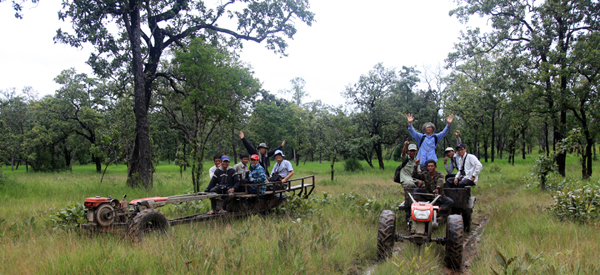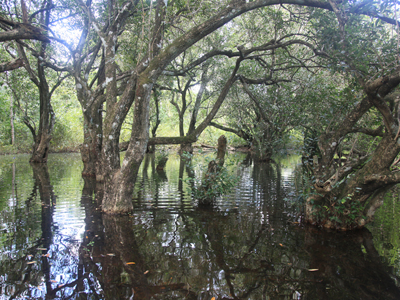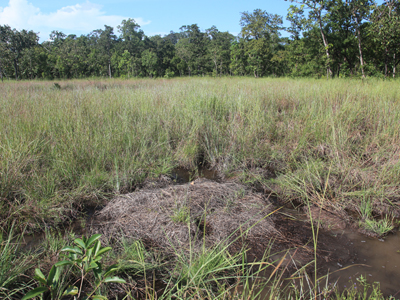
The field team celebrates a successful day of surveys. Their unique field utility tractors (pictured) allow them to cover large distances through the forest. Photo by Tran Triet View more images from the surveys on ICF’s Facebook page.
 ICF’s Southeast Asia Program Director and wetland botanist, Dr. Tran Triet, shares his recent field notes from Kulen Promtep Wildlife Sanctuary, Northern Plain, Cambodia – the heartland of the open Dipterocarp forest ecosystem of Southeast Asia where the vulnerable Sarus Crane nests.
ICF’s Southeast Asia Program Director and wetland botanist, Dr. Tran Triet, shares his recent field notes from Kulen Promtep Wildlife Sanctuary, Northern Plain, Cambodia – the heartland of the open Dipterocarp forest ecosystem of Southeast Asia where the vulnerable Sarus Crane nests.
Eight of us, four Cambodians, a Laotian and three Vietnamese, just finished a field survey to map wetlands and locate Sarus Crane nests. This was the first field excursion under a research project funded by the United States Geological Survey (USGS) and SUMMERNET. It rained hard almost every day of the survey, especially at night. Monsoonal rains filled up wetlands to their fullest capacity, turning a desert-like forest of half-a-year ago into virtually a water world. Water was everywhere. We often couldn’t tell where the wetland ended and where the upland began. The whole sanctuary (some 1.2 million acres) was transformed into a gigantic wetland. Everywhere there were aquatic plants, birds, fishes, frogs, crabs, snails – and lots of them. What else would we ask for from a wetland? Life fully manifested itself, indulging in the luxury of the abundance of water and food, busy producing offspring for the generations to come and, perhaps most importantly, storing enough energy to endure the harsh dry season that will very soon descend upon the region.
F or a wetland botanist, few things could make me as happy as seeing so many wetland plants in full bloom. Many of these plants will either disappear or be unidentifiable in the dry season. We can’t wait to return to this sanctuary in May or early June at the onset of the rainy season, an ecological equivalent of spring time in the Midwest, when a special group of wetland plants will bloom. These “spring ephemeral” plants live shortly and can only be seen during the time when the dry season progresses to the wet. That is also the time when the Sarus Cranes return to their breeding grounds.
or a wetland botanist, few things could make me as happy as seeing so many wetland plants in full bloom. Many of these plants will either disappear or be unidentifiable in the dry season. We can’t wait to return to this sanctuary in May or early June at the onset of the rainy season, an ecological equivalent of spring time in the Midwest, when a special group of wetland plants will bloom. These “spring ephemeral” plants live shortly and can only be seen during the time when the dry season progresses to the wet. That is also the time when the Sarus Cranes return to their breeding grounds.
Photos: Upper right, a forest is transformed by the rainy season. Lower right, a Sarus Crane nest from the spring. Photos by Tran Triet
Siem Riep, Cambodia 10/7/2014
